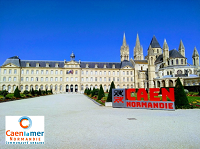Orateur
Description
To study the pion production in heavy-ion collisions, we developed the transport model [1] which combines the nucleon dynamics obtained by the antisymmetrized molecular dynamics (AMD) model with a newly developed transport code which we call sJAM. In the previous work [1], we treated the collision terms of the $NN \leftrightarrow N \Delta$ and $\Delta \leftrightarrow N \pi$ processes with the rigorous conservation of energy and momentum under the presence of momentum-dependent potentials for the initial and final particles of the process. The potentials affect not only the threshold condition for the process but also the cross section in general as a function of the momenta of the initial particles, which is treated in a natural way. We found that the momentum dependence of the neutron and proton potentials has a significant impact on the $NN \to N \Delta$ process, and this information is strongly reflected in the charged pion ratio ($\pi^-/\pi^+$). However, the pion potentials were not included in the previous work~[1]. In the present work, we include the pion potentials in the AMD+sJAM model to study the effect of the pion potential on the pion production in heavy-ion collisions. We find that the pion potentials not only directly affect the $\Delta\to N\pi$ process and the mean field propagation of pions, but also the $\Delta$ production such as $NN \leftrightarrow N \Delta$ due to the change in the $\Delta$ spectral function and the $\Delta$ decay width. We will discuss how the pion potentials affect the pion observables in the heavy-ion collisions.
[1] N. Ikeno and A. Ono, Phys. Rev. C 108, 044601 (2023).

